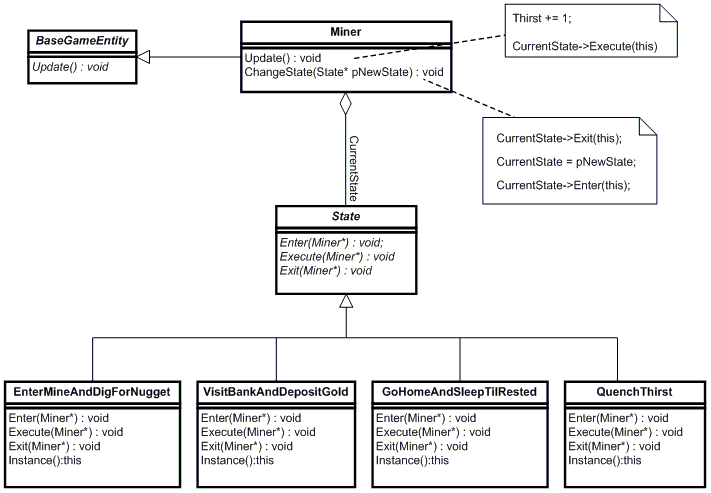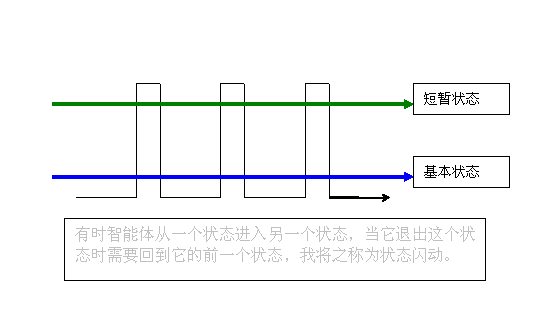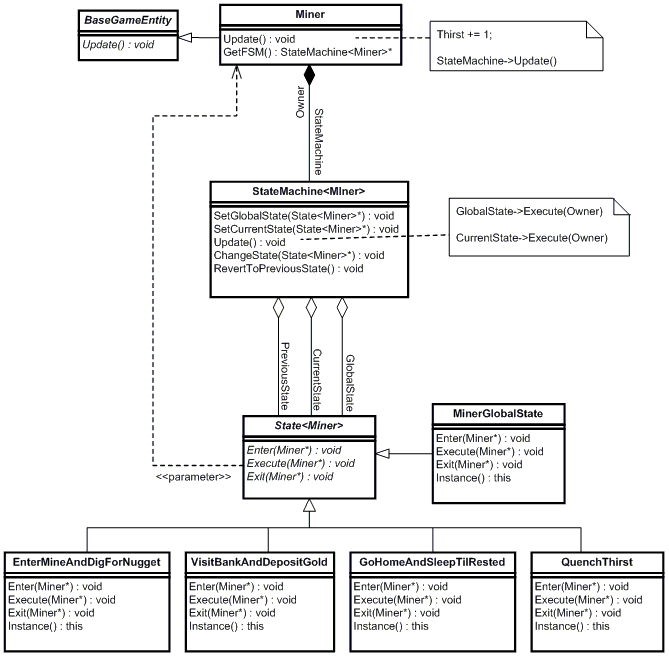状态驱动的游戏智能体设计
- They are quick and simple to code.There are many ways of programming a finite state machine and almost all of them are reasonably simple to implement. You’ll see several alternatives described in this article together with the pros and cons of using them.
- 可以快速简单地编写代码。实现有限状态机有多种途径,而且都可以简单实现。在本文你就能看到多种描述和赞成或者反对使用它们的理由。
- They are easy to debug.Because a game agent’s behavior is broken down into easily manageable chunks, if an agent starts acting strangely, it can be debugged by adding tracer code to each state. In this way, the AI programmer can easily follow the sequence of events that precedes the buggy behavior and take action accordingly.
- 易于调试。因为一个游戏智能体的行为由一个易于管理的代码段来实现,如果一个智能出现奇怪的行为,可以通过为每一个状态增加Tracer来调试。这样能够容易地跟踪事件序列,就可以针对之前的怪异行为修改代码了。
- They have little computational overhead.Finite state machines use hardly any precious processor time because they essentially follow hard- coded rules. There is no real “thinking” involved beyond the if-this-then-that sort of thought process.
- 需要付出一点计算代价。有限状态机几乎不使用宝贵的处理器时间,因为他们本质上跟硬编码是一样的。在那种“如果这样就那样”的思考处理中根本不存在真正的“思考”。
- They are intuitive.It’s human nature to think about things as being in one state or another and we often refer to ourselves as being in such and such a state. How many times have you “got yourself into a state” or found yourself in “the right state of mind”? Humans don’t really work like finite state machines of course, but sometimes we find it useful to think of our behavior in this way. Similarly, it is fairly easy to break down a game agent’s behavior into a number of states and to create the rules required for manipulating them. For the same reason, finite state machines also make it easy for you to discuss the design of your AI with non-programmers (with game producers and level designers for example), providing improved communication and exchange of ideas.
- 符合直觉。人类天生就以当前处以这种或者哪种状态来思考事情,所以我们常常听到我们自己处于什么状态的说法。多少次你“让你自己进入状态”或者发现你自己处于“正确的精神状态”?尽管人类并非真的像有限状态机那样工作,但通常我们发现这样有利于我们思考我们的行为。同样地,这易于通过一系列的状态和创造操作规则来实现一个游戏智能体的行为。基于同样的原因,有限状态机能让你和非程序员(如游戏策划和关卡设计师等)更好地进行关于你的AI设计的讨论,改进交流和交换观点。
- They are flexible.A game agent’s finite state machine can easily be adjusted and tweaked by the programmer to provide the behavior required by the game designer. It’s also a simple matter to expand the scope of an agent’s behavior by adding new states and rules. In addition, as your AI skills grow you’ll find that finite state machines provide a solid backbone with which you can combine other techniques such as fuzzy logic or neural networks.
- 可伸缩性。游戏智能体的有限状态机易于调整,能够很容易让程序员实现游戏设计师需要的行为,也易于通过增加新的状态和规则来扩展智能体的行为。此外,随着你AI技术的增进,你将发现有限状态机提供坚实的基础,让你能够把模糊逻辑和神经网络之类的技术组合到游戏中。

|
enum StateType{state_RunAway, state_Patrol, state_Attack};
void Agent::UpdateState(StateType CurrentState)
{
switch(CurrentState)
{
case state_RunAway:
EvadeEnemy();
if (Safe())
{
ChangeState(state_Patrol);
}
break;
case state_Patrol:
FollowPatrolPath();
if (Threatened())
{
if (StrongerThanEnemy())
{
ChangeState(state_Attack);
}
else
{
ChangeState(state_RunAway);
}
}
break;
case state_Attack:
if (WeakerThanEnemy())
{
ChangeState(state_RunAway);
}
else
{
BashEnemyOverHead();
}
break;
}//end switch
}
|
|
Current State
|
Condition
|
State Transition
|
|
Runaway
|
Safe
|
Patrol
|
|
Attack
|
WeakerThanEnemy
|
RunAway
|
|
Patrol
|
Threatened AND StrongerThanEnemy
|
Attack
|
|
Patrol
|
Threatened AND WeakerThanEnemy
|
RunAway
|
|
Class State
{
public:
virtual void Execute (Troll* troll) = 0;
};
|
|
class Troll
{
/* ATTRIBUTES OMITTED */
State* m_pCurrentState;
public:
/* INTERFACE TO ATTRIBUTES OMITTED */
void Update()
{
m_pCurrentState->Execute(this);
}
void ChangeState(const State* pNewState)
{
delete m_pCurrentState;
m_pCurrentState = pNewState;
}
};
|
|
//----------------------------------State_Runaway
class State_RunAway : public State
{
public:
void Execute(Troll* troll)
{
if (troll->isSafe())
{
troll->ChangeState(new State_Sleep());
}
else
{
troll->MoveAwayFromEnemy();
}
}
};
//----------------------------------State_Sleep
class State_Sleep : public State
{
public:
void Execute(Troll* troll)
{
if (troll->isThreatened())
{
troll->ChangeState(new State_RunAway())
}
else
{
troll->Snore();
}
}
};
|
|
Miner Bob: Pickin' up a nugget
Miner Bob: Pickin' up a nugget
Miner Bob: Ah'm leavin' the gold mine with mah pockets full o' sweet gold
Miner Bob: Goin' to the bank. Yes siree
Miner Bob: Depositin’ gold. Total savings now: 3
Miner Bob: Leavin' the bank
Miner Bob: Walkin' to the gold mine
Miner Bob: Pickin' up a nugget
Miner Bob: Ah'm leavin' the gold mine with mah pockets full o' sweet gold
Miner Bob: Boy, ah sure is thusty! Walkin' to the saloon
Miner Bob: That's mighty fine sippin liquor
Miner Bob: Leavin' the saloon, feelin' good
Miner Bob: Walkin' to the gold mine
Miner Bob: Pickin' up a nugget
Miner Bob: Pickin' up a nugget
Miner Bob: Ah'm leavin' the gold mine with mah pockets full o' sweet gold
Miner Bob: Goin' to the bank. Yes siree
Miner Bob: Depositin' gold. Total savings now: 4
Miner Bob: Leavin' the bank
Miner Bob: Walkin' to the gold mine
Miner Bob: Pickin' up a nugget
Miner Bob: Pickin' up a nugget
Miner Bob: Ah'm leavin' the gold mine with mah pockets full o' sweet gold
Miner Bob: Boy, ah sure is thusty! Walkin' to the saloon
Miner Bob: That's mighty fine sippin' liquor
Miner Bob: Leavin' the saloon, feelin' good
Miner Bob: Walkin' to the gold mine
Miner Bob: Pickin' up a nugget
Miner Bob: Ah'm leavin' the gold mine with mah pockets full o' sweet gold
Miner Bob: Goin' to the bank. Yes siree
Miner Bob: Depositin' gold. Total savings now: 5
Miner Bob: Woohoo! Rich enough for now. Back home to mah li'l lady
Miner Bob: Leavin' the bank
Miner Bob: Walkin' home
Miner Bob: ZZZZ...
Miner Bob: ZZZZ...
Miner Bob: ZZZZ...
Miner Bob: ZZZZ...
Miner Bob: What a God-darn fantastic nap! Time to find more gold
|
|
class BaseGameEntity
{
private:
//every entity has a unique identifying number
int m_ID;
//this is the next valid ID. Each time a BaseGameEntity is instantiated
//this value is updated
static int m_iNextValidID;
//this is called within the constructor to make sure the ID is set
//correctly. It verifies that the value passed to the method is greater
//or equal to the next valid ID, before setting the ID and incrementing
//the next valid ID
void SetID(int val);
public:
BaseGameEntity(int id)
{
SetID(id);
}
virtual ~BaseGameEntity(){}
//all entities must implement an update function
virtual void Update()=0;
int ID()const{return m_ID;}
};
|
|
Class Miner : public BaseGameEntity
{
private:
//a pointer to an instance of a State
State* m_pCurrentState;
// the place where the miner is currently situated
location_type m_Location;
//how many nuggets the miner has in his pockets
int m_iGoldCarried;
//how much money the miner has deposited in the bank
int m_iMoneyInBank;
//the higher the value, the thirstier the miner
int m_iThirst;
//the higher the value, the more tired the miner
int m_iFatigue;
public:
Miner(int ID);
//this must be implemented
void Update();
//this method changes the current state to the new state
void ChangeState(State* pNewState);
/* bulk of interface omitted */
};
|
|
void Miner::Update()
{
m_iThirst += 1;
if (m_pCurrentState)
{
m_pCurrentState->Execute(this);
}
}
|
- EnterMineAndDigForNugget: If the miner is not located at the gold mine, he changes location. If already at the gold mine, he digs for nuggets of gold. When his pockets are full, Bob changes state to VisitBankAndDepositGold, and if while digging he finds himself thirsty, he will stop and change state to QuenchThirst.
- EnterMinAndDigForNugget:当Bob不在金矿的时候,他移动到金矿。如果已经在金矿,他会持续掘金。直到他的袋子装满金矿石,Bob将会转换到VisitBankAndDepositGold状态。但如果在掘金的时候觉得饥渴,他就会停下来,把状态转换到QuenchThirst。
- VisitBankAndDepositGold: In this state the miner will walk to the bank and deposit any nuggets he is carrying. If he then considers himself wealthy enough, he will change state to GoHomeAnd- SleepTilRested. Otherwise he will change state to EnterMine- AndDigForNugget.
- VisitBankAndDepositGold:处于这个状态时淘金者会走到储藏库并把带来的金矿石保存起来。如果他觉得自己足够富有,他就转换到GoHomeAndSleepTilRested状态,否则就转换到EnterMineAndDigForNugget。
- GoHomeAndSleepTilRested: In this state the miner will return to his shack and sleep until his fatigue level drops below an acceptable level. He will then change state to EnterMineAndDigForNugget.
- GoHomeAndSleepTilRested:处于此状态的淘金者会返回到他的房子里睡觉,直到疲惫程序下降到可接受的情况,这时转换到EnterMineAndDigForNugget。
- QuenchThirst: If at any time the miner feels thirsty (diggin’ for gold is thusty work, don’t ya know), he changes to this state and visits the saloon in order to buy a whiskey. When his thirst is quenched, he changes state to EnterMineAndDigForNugget.
- QuenchThirst:任何时候当淘金者感到饥渴,他就改变他的状态去商店买威士忌,解渴后转换到EnterMineAndDigForNugget。

|
class State
{
public:
virtual ~State(){}
//this will execute when the state is entered
virtual void Enter(Miner*)=0;
//this is called by the miner’s update function each update-step
virtual void Execute(Miner*)=0;
//this will execute when the state is exited
virtual void Exit(Miner*)=0;
}
|
|
void Miner::ChangeState(State* pNewState)
{
//make sure both states are valid before attempting to
//call their methods
assert (m_pCurrentState && pNewState);
//call the exit method of the existing state
m_pCurrentState->Exit(this);
//change state to the new state
m_pCurrentState = pNewState;
//call the entry method of the new state
m_pCurrentState->Enter(this);
}
|
|
TIP: The state design pattern is also useful for structuring the main components of your game flow. For example, you could have a menu state, a save state, a paused state, an options state, a run state, etc.
提示:状态设计模式对于游戏主流程的组织也是非常有用的,例如,你可能有菜单状态、保存状态、暂停状态、设置状态和运行状态等。
|

|
NOTE I prefer to use singletons for the states for the reasons I’ve already given, but there is one drawback. Because they are shared between clients, singleton states are unable to make use of their own local, agent-specific data. For instance, if an agent uses a state that when entered should move it to an arbitrary position, the position cannot be stored in the state itself (because the position may be different for each agent that is using the state). Instead, it would have to be stored somewhere externally and be accessed by the state via the agent’s interface. This is not really a problem if your states are accessing only one or two pieces of data, but if you find that the states you have designed are repeatedly accessing lots of external data, it’s probably worth considering disposing of the singleton design and writing a few lines of code to manage the allocation and deallocation of state memory.
注意:我乐于使用单件的原因在上文已经给出,但这也有一个缺陷。因为他们由客户共享,单件状态不能使用他们自有的,特定智能体的数据。例如,当某一处于某状态的智能体移动到某一位置时,他不能把这一位置存储在状态内(因为这个状态可能与其它正处于这一状态的智能体不同)。它只能把它存储在其它地方,然后由状态机通过智能体的接口来存取。如果你的状态只有一两个数据要存取,那这也不是什么大问题,但如果你在很多外部数据,那可能就值得考虑放弃单件设计,而转而写一代码来管理状态内存的申请与释放了。
|
|
class EnterMineAndDigForNugget : public State
{
private:
EnterMineAndDigForNugget(){}
/* copy ctor and assignment op omitted */
public:
//this is a singleton
static EnterMineAndDigForNugget* Instance();
virtual void Enter(Miner* pMiner);
virtual void Execute(Miner* pMiner);
virtual void Exit(Miner* pMiner);
};
|
|
void EnterMineAndDigForNugget::Enter(Miner* pMiner)
{
//if the miner is not already located at the goldmine, he must
//change location to the gold mine
if (pMiner->Location() != goldmine)
{
cout << "/n" << GetNameOfEntity(pMiner->ID()) << ": "
<< "Walkin' to the goldmine";
pMiner->ChangeLocation(goldmine);
}
}
|
|
void EnterMineAndDigForNugget::Execute(Miner* pMiner)
{
//the miner digs for gold until he is carrying in excess of MaxNuggets.
//If he gets thirsty during his digging he stops work and
//changes state to go to the saloon for a beer.
pMiner->AddToGoldCarried(1);
//digging is hard work
pMiner->IncreaseFatigue();
cout << "/n" << GetNameOfEntity(pMiner->ID()) << ": "
<< "Pickin' up a nugget";
//if enough gold mined, go and put it in the bank
if (pMiner->PocketsFull())
{
pMiner->ChangeState(VisitBankAndDepositGold::Instance());
}
//if thirsty go and get a beer
if (pMiner->Thirsty())
{
pMiner->ChangeState(QuenchThirst::Instance());
}
}
|
|
void EnterMineAndDigForNugget::Exit(Miner* pMiner)
{
cout << "/n" << GetNameOfEntity(pMiner->ID()) << ": "
<< "Ah'm leavin' the goldmine with mah pockets full o' sweet gold";
}
|
|
template <class entity_type>
class State
{
public:
virtual void Enter(entity_type*)=0;
virtual void Execute(entity_type*)=0;
virtual void Exit(entity_type*)=0;
virtual ~State(){}
};
|
|
class EnterMineAndDigForNugget : public State<Miner>
{
public:
/* OMITTED */
};
|
|
//notice how now that State is a class template we have to declare the entity type
State<Miner>* m_pGlobalState;
|

|
class Miner : public BaseGameEntity
{
private:
State<Miner>* m_pCurrentState;
State<Miner>* m_pPreviousState;
State<Miner>* m_pGlobalState;
...
public:
void ChangeState(State<Miner>* pNewState);
void RevertToPreviousState();
...
};
|
|
template <class entity_type>
class StateMachine
{
private:
//a pointer to the agent that owns this instance
entity_type* m_pOwner;
State<entity_type>* m_pCurrentState;
//a record of the last state the agent was in
State<entity_type>* m_pPreviousState;
//this state logic is called every time the FSM is updated
State<entity_type>* m_pGlobalState;
public:
StateMachine(entity_type* owner):m_pOwner(owner),
m_pCurrentState(NULL),
m_pPreviousState(NULL),
m_pGlobalState(NULL)
{}
//use these methods to initialize the FSM
void SetCurrentState(State<entity_type>* s){m_pCurrentState = s;}
void SetGlobalState(State<entity_type>* s) {m_pGlobalState = s;}
void SetPreviousState(State<entity_type>* s){m_pPreviousState = s;}
//call this to update the FSM
void Update()const
{
//if a global state exists, call its execute method
if (m_pGlobalState) m_pGlobalState->Execute(m_pOwner);
//same for the current state
if (m_pCurrentState) m_pCurrentState->Execute(m_pOwner);
}
//change to a new state
void ChangeState(State<entity_type>* pNewState)
{
assert(pNewState &&
"<StateMachine::ChangeState>: trying to change to a null state");
//keep a record of the previous state
m_pPreviousState = m_pCurrentState;
//call the exit method of the existing state
m_pCurrentState->Exit(m_pOwner);
//change state to the new state
m_pCurrentState = pNewState;
//call the entry method of the new state
m_pCurrentState->Enter(m_pOwner);
}
//change state back to the previous state
void RevertToPreviousState()
{
ChangeState(m_pPreviousState);
}
//accessors
State<entity_type>* CurrentState() const{return m_pCurrentState;}
State<entity_type>* GlobalState() const{return m_pGlobalState;}
State<entity_type>* PreviousState() const{return m_pPreviousState;}
//returns true if the current state’s type is equal to the type of the
//class passed as a parameter.
bool isInState(const State<entity_type>& st)const;
};
|
|
class Miner : public BaseGameEntity
{
private:
//an instance of the state machine class
StateMachine<Miner>* m_pStateMachine;
/* EXTRANEOUS DETAIL OMITTED */
public:
Miner(int id):m_Location(shack),
m_iGoldCarried(0),
m_iMoneyInBank(0),
m_iThirst(0),
m_iFatigue(0),
BaseGameEntity(id)
{
//set up state machine
m_pStateMachine = new StateMachine<Miner>(this);
m_pStateMachine->SetCurrentState(GoHomeAndSleepTilRested::Instance());
m_pStateMachine->SetGlobalState(MinerGlobalState::Instance());
}
~Miner(){delete m_pStateMachine;}
void Update()
{
++m_iThirst;
m_pStateMachine->Update();
}
StateMachine<Miner>* GetFSM()const{return m_pStateMachine;}
/* EXTRANEOUS DETAIL OMITTED */
};
|


|
Miner Bob: Pickin' up a nugget
Miner Bob: Ah'm leavin' the gold mine with mah pockets full o' sweet gold
Miner Bob: Goin' to the bank. Yes siree
Elsa: Walkin' to the can. Need to powda mah pretty li'l nose
Elsa: Ahhhhhh! Sweet relief!
Elsa: Leavin' the john
Miner Bob: Depositin' gold. Total savings now: 4
Miner Bob: Leavin' the bank
Miner Bob: Walkin' to the gold mine
Elsa: Walkin' to the can. Need to powda mah pretty li'l nose
Elsa: Ahhhhhh! Sweet relief!
Elsa: Leavin' the john
Miner Bob: Pickin' up a nugget
Elsa: Moppin' the floor
Miner Bob: Pickin' up a nugget
Miner Bob: Ah'm leavin' the gold mine with mah pockets full o' sweet gold
Miner Bob: Boy, ah sure is thusty! Walkin' to the saloon
Elsa: Moppin' the floor
Miner Bob: That's mighty fine sippin' liquor
Miner Bob: Leavin' the saloon, feelin' good
Miner Bob: Walkin' to the gold mine
Elsa: Makin' the bed
Miner Bob: Pickin' up a nugget
Miner Bob: Ah'm leavin' the gold mine with mah pockets full o' sweet gold
Miner Bob: Goin' to the bank. Yes siree
Elsa: Walkin' to the can. Need to powda mah pretty li'l nose
Elsa: Ahhhhhh! Sweet relief!
Elsa: Leavin' the john
Miner Bob: Depositin' gold. Total savings now: 5
Miner Bob: Woohoo! Rich enough for now. Back home to mah li'l lady
Miner Bob: Leavin' the bank
Miner Bob: Walkin' home
Elsa: Walkin' to the can. Need to powda mah pretty li'l nose
Elsa: Ahhhhhh! Sweet relief!
Elsa: Leavin' the john
Miner Bob: ZZZZ...
|
状态驱动的游戏智能体设计相关推荐
- 状态驱动的游戏智能体设计(下)
本文由恋花蝶最初发表于http://blog.csdn.net/lanphaday,欢迎转载,但必须保持全文完整,也必须包含本声明. 译者并示取得中文版的翻译授权,翻译本文只是出于研究和学习目的.任何 ...
- 状态驱动的游戏智能体设计(中)
本文由恋花蝶最初发表于http://blog.csdn.net/lanphaday,欢迎转载,但必须保持全文完整,也必须包含本声明. 译者并示取得中文版的翻译授权,翻译本文只是出于研究和学习目的.任何 ...
- 状态驱动的游戏智能体设计(上)
本文由恋花蝶最初发表于http://blog.csdn.net/lanphaday,欢迎转载,但必须保持全文完整,也必须包含本声明. 译者并示取得中文版的翻译授权,翻译本文只是出于研究和学习目的.任何 ...
- 游戏程序开发:状态驱动的游戏智能体设计 (二)
转自: 状态驱动的游戏智能体设计(一) http://edu.gamfe.com/tutor/d/30601.html 状态驱动的游戏智能体设计(二) http://edu.gamfe.com/tut ...
- 通过深度Q网络DQN构建游戏智能体
目录 什么是深度Q网络(DQN) DQN的基本结构 DQN的关键技术 用Python和Gym实现DQN 算法优化 1. 网络结构优化 2. 训练策略优化 3. 超参数优化 欢迎来到我的博客,今天我们将 ...
- 软件学院20周年院庆系列讲座 | 可微仿真与机器人智能体设计
可微仿真与机器人智能体设计 来源:清软小研
- 2022年第十七届研电赛报名|安谋科技(Arm China)命题:基于特定开发平台的理性智能体设计
"兆易创新杯"第十七届中国研究生电子设计竞赛(以下简称"研电赛")现已正式开赛,企业命题已在官网发布,现官网已启动报名啦~ 安谋科技作为研电赛多年的合作单位及& ...
- 传奇黑客成『吹哨人』,推特麻烦了;谷歌20+技术学习路线;Python数据科学电子书;游戏智能体开发平台;前沿论文 | ShowMeAI资讯日报
ShowMeAI日报系列全新升级!覆盖AI人工智能 工具&框架 | 项目&代码 | 博文&分享 | 数据&资源 | 研究&论文 等方向.点击查看 历史文章列表, ...
- 多智能体强化学习及其在游戏AI上的应用与展望
近年来,人工智能技术在很多领域都取得了亮眼成就,并逐步从感知智能向决策智能迈进.强化学习是实现决策智能的重要路径,而现实世界中往往存在着多智能体的交互,也催生了多智能体强化学习的发展.这篇文章主要对多 ...
最新文章
- python读写文件绝对路径_[Spark][Python]对HDFS 上的文件,采用绝对路径,来读取获得 RDD...
- 部署时服务端Excel的COM设置
- 数据库面试题【七、InnoDB索引和MyISAM索引的区别】
- Spring+Hibernate+Atomikos集成构建JTA的分布式事务--解决多数据源跨库事务
- 8月29日见!卢伟冰:Redmi首款互联网电视将采用70英寸巨屏
- JBox - 模态窗口,工具提示和消息 jQuery 插件
- java string debug_java 中 string 对象
- Ubuntu配置静态IP以及interfaces配置不生效问题解决
- 读《南怀瑾讲人生哲理》
- QT3D场景的快速绘制
- h5页面如何预览excel文件_如何使用JavaScript实现前端导入和导出excel文件?(H5编辑器实战复盘)...
- 参考线--深入了解字体
- Dijkstra算法指定任意两点距离(邻接矩阵法)
- ESP8266—01模块的3种工作模式
- CORDIC算法原理详解及其Verilog实现
- 分享国产32位单片机灵动微MM32F主流型和超值型
- IPFS Java实现
- B2B行业网站销售方式及销售工作内容
- axure的html按钮设置背景,Axure格式和样式功能详解
- (十)机房收费系统操作手册
热门文章
- [WARNING] The POM for com.tenyears:base-common:jar:1.0 is invalid, transitive dependen
- 【C语言--字符数据的输入输出】
- 通过命令行启动Unity并激活ZSpace和OpenGL(从新账户转)
- 2021年中国稀土永磁材料行业现状及政策分析,高性能钕铁硼未来应用前景广阔「图」
- 台式网卡计算机,台式机网卡,台式机网卡在哪里
- 宽平稳和严平稳的区别
- 4路/8路模拟CVBS摄像头TW6865/TW6869 i.MX6四核工业级Android、Linux、STM32、NXP
- 斜拉桥主梁的预应力混凝土横梁计算midas
- GoTo Group上市首日市值达315亿美元;星巴克推出“明日的拿铁”创意饮食;华住出台“专项融资扶持计划” | 美通企业日报...
- Vue学习第三天路由Vue Route(9月6号)
